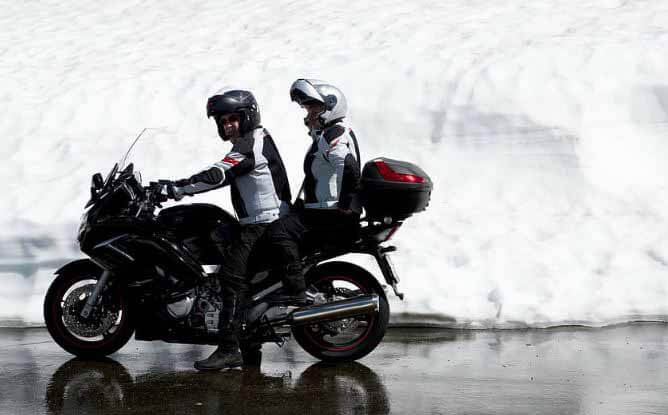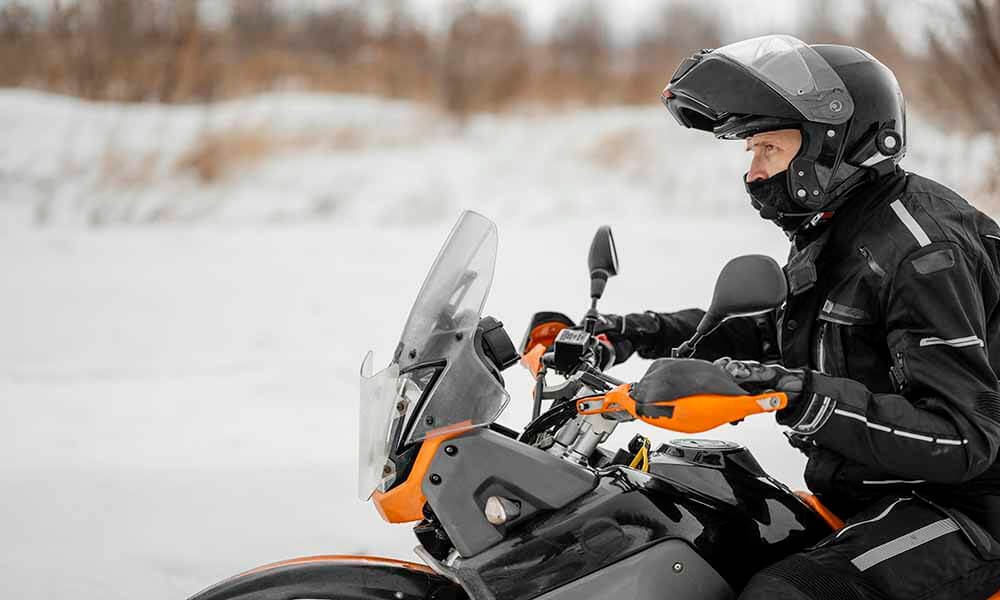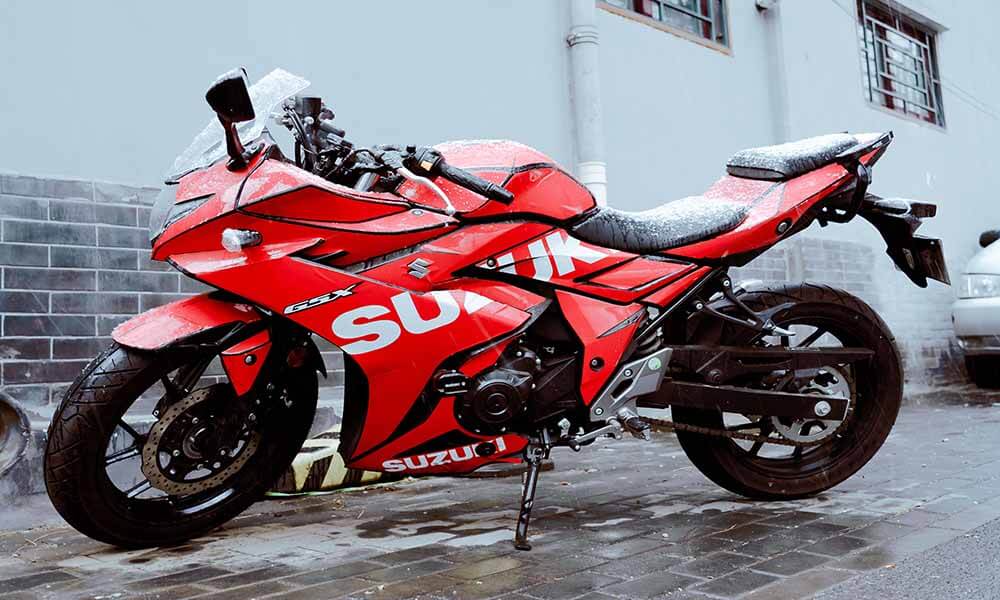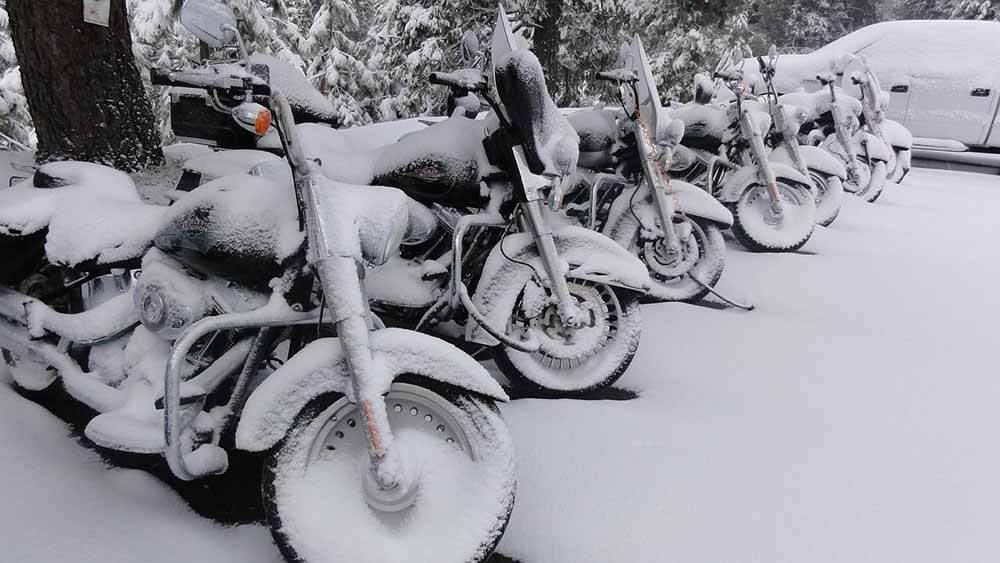As the days start getting longer, and the warm evening breeze starts to get a cold edge, it’s a sure sign, at least for those in the northern regions, that the green landscape is soon to become white. With the exception of those among us that relish these conditions, most of us will be starting to think about parking the bike up for the year (or whether a 6-month secondment to Florida is a possibility. This i when you ask yourself “Do I have to Winterize my Motorcycle now?
When you’re new to motorcycles, it seems everyone has an opinion on whether you should winterize your motorcycle. The problem is everyone’s opinion is different. So, what’s the definitive word, do I have to winterize my motorcycle?
It’s All About the Weather and Your Preference
The simple answer is, no, there are no rules or regulations that say you must stay off your motorcycle over the winter months, and for those of us in the southern states and regions, it’s not an issue. Those who are so far north must look south to see the Northern lights, up in Canada and Alaska are probably sitting there wondering why this is even a question, but for those in between the two extremes, it comes down to the weather and your preference.
Except for the ex-marines among us, most of us tend to winterize our bikes when the roads start getting icy and snowy for safety reasons and because it’s too cold on the back of the bike in these climates.
Of course, there are times when you know that you might not have the opportunity to ride for several months, or you might need to put your bike in storage. Much of this article is relevant to those in your situation as well.
Tips for Winterizing Your Bike
When it comes time to put your bike away for the year, here are some tips to make sure it’s ready to ride come spring:
Look After Your Gasoline
Let’s be honest, gasoline is too expensive these days to let go to waste, so it’s one of the things you should look after when it comes to winterizing your bike. If you don’t the falling octane rating that results from not being properly stored might be the least of your worries. When the fuel system is probably not sorted before your bike is stored for winter, you run the risk of sludge throughout the coming spring, which decreases the chance of your motorcycle starting first go exponentially.
When you don’t sort the gasoline out, the lighter molecules can evaporate in as little time as a month, leaving behind heavier hydrocarbons. The thicker fluid that remains oxidizes and thickens further with the ethanol that is now a feature of most modern-day gasoline, further worsening the situation by drawing the moisture out of the air to add water to the mix.
If your bike runs with a carburetor, then it’s a case of draining everything and storing it dry. If your bike is fuel injected, it’s almost impossible to get all the fuel out of the system, so do the opposite, fill the tank, and add a high-quality fuel stabilizer. This will stop the oxidization process for up to one year and keep the ethanol side effects at bay.
Related: Can You Leave Gas in the Motorcycle Over Winter? Find Out Here!
Avoid a Dead Battery Come Spring
Nothing worse than being all set for the ride you’ve been waiting six months for only to find the battery on the bike dead. The lead batteries that most bikes depend on have a tendency to self-discharge when they’re left to their own devices for a month or three.
The cells on the battery create sulfate crystals as the voltage discharge. This sulphation is a part of the chemical process that turns lead into oxide and sulphuric acid into electricity. However, when the bike is running normally these dissolves once the bike is started and the current flows through the battery.
Not so if it’s sitting dormant and there’s no resuscitation of the battery in the worst-case scenario. The best way around this is to connect your battery to a smart charger or maintainer as part of your winterization process.
You May Also Like: How Often Should I Start My Motorcycle in Winter?
Basic Housekeeping (Bike Keeping)
There are some other basic things to do when winter rolls round, and while they are probably among the last things you want to be doing when you won’t get to ride your motorbike for the next few months, they are important, and you won’t regret it come spring.
1. Wash and Clean
Before you put your bike away for the year, give it a good wash and clean off all the dirt, bugs, and grime that have accumulated over the year. Leaving your bike dirty for long periods can affect the paint job and cause corrosion. Give the bike a wax and polish when you’re done, use a silicon detailer on the plastics, and give the chrome a light coat of WD40.
2. Lube the Chain
After a good wash, apply a coat of lube to the chain. The purpose of the lube is to keep the chain from rusting, so this is one occasion when being liberal with the lube won’t hurt (within reason).
3. Cover the Machine
Invest in a good cover and keep your motorcycle covered over the winter months. If you don’t, come spring it’s likely to be covered in dust and it looks like it hasn’t been washed for years. The ideal cover is something synthetic and breathable. An old cotton sheet used to be the gold standard, but it can cause mildew, which also attracts rodents.
4. Remember the Fluids
Gasoline is just one of the fluids that you need to deal with on your motorcycle before winterizing. You should also check the coolant to ensure that there’s adequate anti-freeze and corrosion protection. It’s always worth making an oil change if one is even close to due. That way everything is fresh for the next season of riding.
5. Don’t Forget the Tires
The end of the riding year is a great time to check your tires for wear. If all is good, then make sure they are inflated to the correct pressure before stashing your bike away. Failing to do this can result in cracked or brittle tires the next time you fire up the Nike.
Information for this article was partially sourced and researched from the following authoritative Government, educational, corporate, and nonprofit organizations:
Weatherization Assistance Program Providers
Prepare your vehicle for winter driving
About the author:
Michael Parrotte was the Vice President of AGV Helmets America, and a consultant for KBC Helmets, Vemar Helmets, Suomy Helmets, Marushin Helmets, KYT Helmets, and Sparx Helmets. In addition, he is the founder and owner of AGV Sports Group.
Click here for all of Michael’s contact and Social Media information https://parrotte.com/
Click here for all AGV Sports Group Social Media information http://agvsport.info/
FM/L




